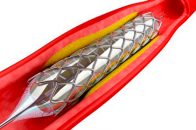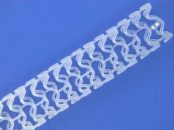Fentanyl is a potent opiate commonly administered in the cath lab. Recently, questions on its safety have been raised by research demonstrating that intravenous morphine significantly delays the absorption of oral P2Y12 platelet inhibitors. The mechanism might be slowed gastric emptying. The Platelet Aggregation with tiCagrelor Inhibition and FentanYl (PACIFY) trial enrolled 212 patients undergoing indicated…
2.0-mm DES for Very Small Vessels: Are They Viable?
The reference vessel diameter is a fundamental factor for restenosis after coronary angioplasty even with drug-eluting stents. The smallest sized stents available are 2.25 mm in diameter, but even smaller vessels can be symptomatic. This was a prospective multicenter trial of the Resolute Onyx 2.0-mm zotarolimus-eluting stent. The primary endpoint was target lesion failure. Read also: “Effects…
Effects of Cerebral Radiation on Interventional Cardiologists
In recent years, there has been a growing concern about the occupational hazard for interventional cardiologists who have high and unprecedented levels of ionizing radiation exposure. microRNAs are a class of short and highly conserved non-coding RNA molecules (about 22 nucleotides) that become altered (dysregulated) in many diseases. Read also: “Nearly half of interventional cardiologists may…
Excellent Outcomes for the First Sirolimus Eluting Balloon Tested on Instent Restesosis
Much has been done since studies on conventional balloon angioplasty for BMS instent restenosis showed over 40% new revascularization. Drug eluting stents, aimed at improving this problem, have never achieved 0% restenosis, which is why technologies such as paclitaxel coated balloons have been developed, with reasonable efficacy (8% to 10% reinterventions rate for BMS restenosis and 17% to 23%…
Bioresorbable Scaffolds Must Not Be Chosen Over Current DES
Although there are 4 approved bioresorbable scaffolds (BRS) in Europe, experts suggest that current drug-eluting stents (DES) are the best option for coronary angioplasty. These new guidelines jointly published by the European Society of Cardiology (ESC) and the Association of Percutaneous Cardiovascular Interventions (EAPCI) are an update on the use of BRS in clinical practice…
Impella Improves Safety in High Risk Unprotected Left Main PCI
Courtesy of Dr. Carlos Fava. The incidence of unprotected left main severe stenosis ranges between 4 and 8%, and it’s mostly associated with multivessel disease. The use of left ventricular support devices in high risk unprotected left main PCI is on the rise, but not much information available in this regard. Read also: “Prior assistance…
Early Coronary Angiography in High-Risk Non-ST-Elevation ACS
Coronary angiography is essential for patients admitted with non-ST-elevation acute coronary syndrome, since it allows physicians to confirm the diagnosis, stratify the risk, and define the revascularization and antithrombotic management strategies. There is no doubt that these patients should be studied invasively, but the timing for that is still uncertain. Coronary catheterization within…
With Absorb Out, New Resorbable Scaffolds Have Come onto the Market
By restoring vascular physiology and eliminating the inflammatory focus and the chance of fracture and neo atherosclerosis inherent to DES, bioresorbable scaffolds offer the potential to improve long term outcomes. A number of bioresorbable materials have been tested, mainly polylactic acid, with several limitations that have taken the Absorb bioresorbable scaffold out of the market.…
Frequency and Evolution of Cardiac Perforation in Patients with a History of MRS
Courtesy of Dr. Carlos Fava. Coronary perforation (CP) is a very uncommon event (≈0.4%), associated with severe complications that entail risk of death. It has usually been related to patients with a history of myocardial revascularization surgery (MRS). However, this group usually presents lower rates of cardiac tamponade due to pericardial fibrosis caused by surgery. This…
Diabetics’ Silent Ischemia Myth Busted
Diabetes mellitus patients generally present more diffuse coronary disease, faster lesion progression and higher risk of restenosis after PCI. The way these anatomical differences translate into in a different clinical practice, compared to non-diabetic patients, remains unclear. Prior studies comparing the frequency of angina symptoms in diabetic vs. non-diabetic patients have arrived to contradicting outcomes,…
These Are the Thrombosis Predictors for Absorb Bioresorbable Scaffolds
J Am Coll Cardiol Intv has recently published a special issue on bioresorbable scaffolds. Abbott’s decision to pull Absorb off the market probably prompted the fast publishing of all related articles sent to the journal. Bioresorbable scaffolds were developed in hopes that they would reduce the rates of events per year 1 year post-implantation by 1.5%-3%…










